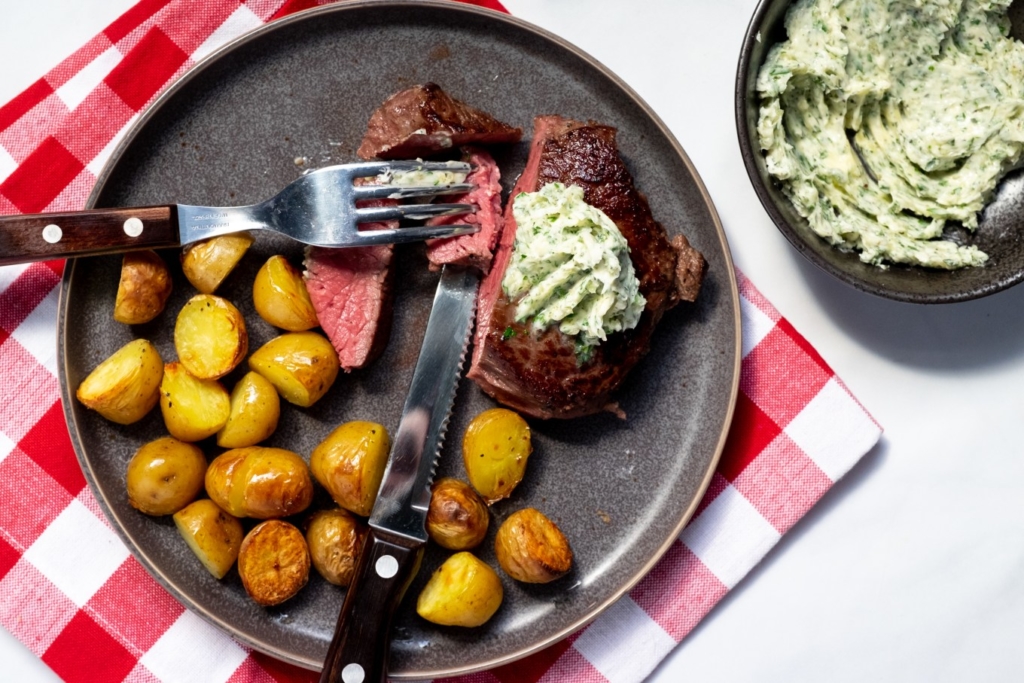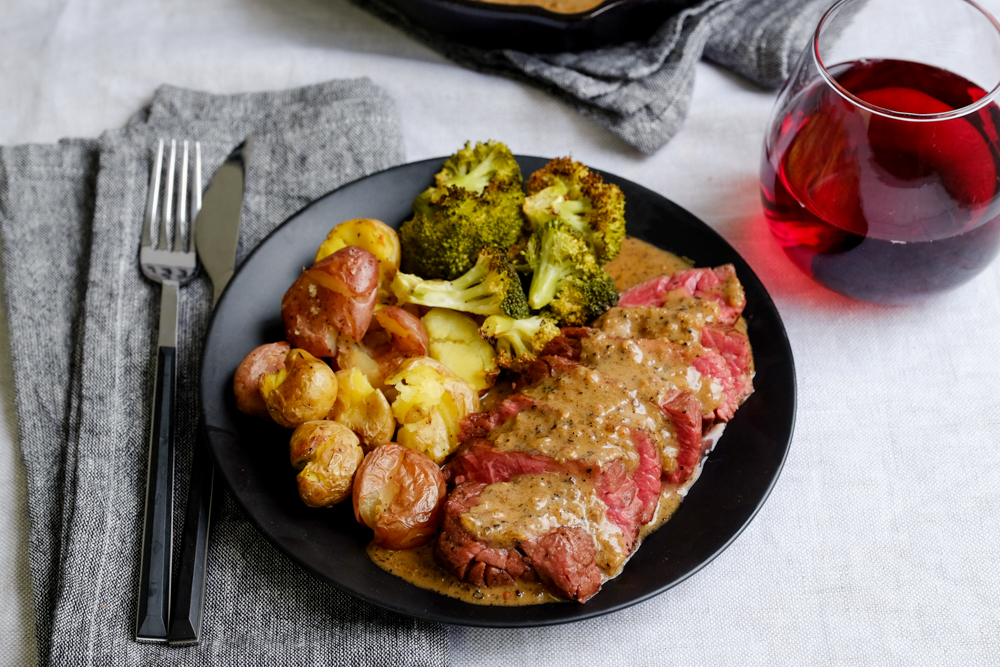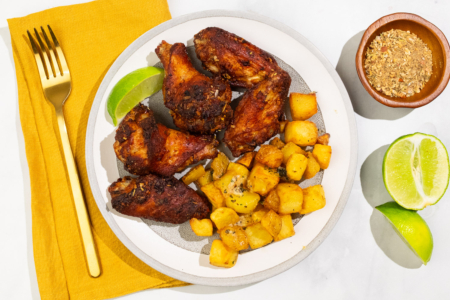Nothing beats a meaty and juicy steak cooked to perfection. Unfortunately, cooking steak using conventional methods is difficult to master. That’s where the sous vide cooking method comes in. Cooking steak using Suvie or sous vide allows you to cook the meat to the exact level of doneness without fail. All that’s required at the end is a quick sear and the resulting steak will be tender, juicy and absolutely packed with flavor.
Here’s how to cook steak using sous vide.
1. Beef Tenderloin Cooking Temperatures and Times
2. Flank Steak Cooking Temperatures and Times
3. Flat Iron Steak Cooking Temperatures and Times
4. Ribeye Steak Cooking Temperatures and Times
5. Sirloin Steak Cooking Temperatures and Times
6. Sirloin Cap Steak Cooking Temperatures and Times
7. Skirt Steak Cooking Temperatures and Times
8. Strip Steak Cooking Temperatures and Times
9. Tri Tip Steak Cooking Temperatures and Times
10. Ingredients and Tools
11. Preparation
12. Suvie Directions
13. Immersion Circulator Directions
14. Finishing
15. Recipes
16. FAQs
Beef Tenderloin

Beef tenderloin, or filet mignon if you prefer, is a premium cut of beef that needs to be treated with care and attention. The name “tenderloin” isn’t accidental, these barely used muscles come from the loin portion of the cow and are the most tender cuts of beef available. The lack of fatty marbleisation in tenderloin makes it susceptible to overcooking.
| Temperature | Time | Result |
| 125°F* | 1-3 hours | Rare |
| 130°F | 1-3 hours | Medium rare |
| 135°F | 1-3 hours | Medium |
| 145°F | 1-3 hours | Medium Well |
| 150°F | 1-3 hours | Well done |
Flank

This thin and lean cut of meat comes from the abdominal region of cattle. While prized for its meaty flavor, flank is a well-used muscle and as a result it can be very tough and chewy. That’s where sous vide comes in. Flank steak cooked using Suvie or sous vide is wonderfully tender and packed full of beefy flavor.
| Temperature | Time | Result |
| 125°F* | 1-3 hours | Rare |
| 130°F | 1-3 hours | Medium rare |
| 135°F | 1-3 hours | Medium |
| 145°F | 1-3 hours | Medium Well |
| 150°F | 1-3 hours | Well done |
Flat Iron

Although it’s technically taken from the chuck region of the cow if cooked correctly the Flat iron can be as tender as the more expensive tenderloin cut. Flat iron is an ideal steak to cook sous vide, the low and slow cooking method used by sous vide and Suvie helps to break down the fibrous tissue without overcooking the meat. The result is a perfect blend of beefy flavor and satisfying texture.
| Temperature | Time | Result |
| 125°F* | 1-3 hours | Rare |
| 130°F | 1-3 hours | Medium rare |
| 135°F | 1-3 hours | Medium |
| 145°F | 1-3 hours | Medium Well |
| 150°F | 1-3 hours | Well done |
Ribeye

Ribeye is undoubtedly our favorite cut of beef and a go-to choice at any steakhouse. Beautifully marbled with a pleasant texture and a powerfully beefy flavor, Ribeye is the steak lovers steak. It’s also extremely expensive so it’s crucial when cooking at home to get it right unless you like overcooked chewy leather that is. Cooking using sous vide and Suvie is the ideal way to get the best out of this cut.
| Temperature | Time | Result |
| 125°F* | 1-3 hours | Rare |
| 130°F | 1-3 hours | Medium rare |
| 135°F | 1-3 hours | Medium |
| 145°F | 1-3 hours | Medium Well |
| 150°F | 1-3 hours | Well done |
Sirloin

Sirloin is a relatively affordable cut of meat that tastes good and is a staple at many cookouts and BBQs. Sirloin comes from the rear flank of the cow and is a relatively lean cut of meat with very little marbleization. As a result, it can be overly chewy and tough if not prepared correctly.
| Temperature | Time | Result |
| 125°F* | 1-3 hours | Rare |
| 130°F | 1-3 hours | Medium rare |
| 135°F | 1-3 hours | Medium |
| 145°F | 1-3 hours | Medium Well |
| 150°F | 1-3 hours | Well done |
Sirloin Cap

Chances are, unless you frequent Brazilian BBQ joints, you’ve never heard of a sirloin cap. This under-rated cut of beef is remarkably popular in Brazil where it goes by the name of picanha. As the name suggests, this steak comes from the same region as regular sirloin and is functionally similar to in terms of flavor and texture. However, unlike sirloin, this steak is capped with a thick slab of fat. This slab of fat can be kept on and will baste the meat as it is cooked.
| Temperature | Time | Result |
| 125°F* | 1-3 hours | Rare |
| 130°F | 1-3 hours | Medium rare |
| 135°F | 1-3 hours | Medium |
| 145°F | 1-3 hours | Medium Well |
| 150°F | 1-3 hours | Well done |
Skirt

While it has a reputation for being overly tough, skirt steak is prized for its intense meaty flavor. Like flank steak, when cooked correctly, skirt steak is rich and tasty, but if cooked incorrectly it can get extremely tough and fibrous. That’s where sous vide comes in. The low and slow cooking method used by sous vide and Suvie helps to break down the tough fibrous tissue without overcooking the meat.
| Temperature | Time | Result |
| 125°F* | 1-3 hours | Rare |
| 130°F | 1-3 hours | Medium rare |
| 135°F | 1-3 hours | Medium |
| 145°F | 1-3 hours | Medium Well |
| 150°F | 1-3 hours | Well done |
Strip

A common fixture in steakhouses, strip steaks are prized by butchers (and customers) for their beefy flavor, tender texture, and intense marbleization. Strip steaks, or New York strip steaks as they’re sometimes called comes from the beef short loin primal. The short loin is muscle area that does very little work, as a result it’s home to many of the best beef cuts, including the tenderloin. Strip steak is a premium cut of meat with a premium price tag which can make it a daunting prospect for home cooking.
| Temperature | Time | Result |
| 125°F* | 1-3 hours | Rare |
| 130°F | 1-3 hours | Medium rare |
| 135°F | 1-3 hours | Medium |
| 145°F | 1-3 hours | Medium Well |
| 150°F | 1-3 hours | Well done |
Tri Tip

Tri-tip, or Newport is a relatively obscure steak that comes from the bottom sirloin region of the cow. Tri-tip is a lean cut of beef and so it is often cooked Santa Maria-style; a fast and hot grilling method where the meat is cooked to medium-rare over an open fire. The hot and fast method works well for this cut of beef but so does the low and slow precision of sous vide.
| Temperature | Time | Result |
| 125°F* | 1-3 hours | Rare |
| 130°F | 1-3 hours | Medium rare |
| 135°F | 1-3 hours | Medium |
| 145°F | 1-3 hours | Medium Well |
| 150°F | 1-3 hours | Well done |
*Please note that some of these temperatures are lower than what the FDA recommends. Consuming raw or undercooked meats, poultry, seafood, shellfish, or eggs may increase your risk of food-borne illness.
Ingredients and Tools
- Steak
- Salt
- Pepper
- Vegetable oil or butter
- Garlic, herbs, and spices (optional)
Equipment
- Suvie or immersion circulator
- A large pot (if using an immersion circulator)
- Vacuum sealer and bags or Freezer safe sealable plastic bags
- A skillet (preferably cast iron)
Preparation
If you’re using an immersion circulator, pre-heat your water bath to the desired temperature

Pat steak dry and season generously with with salt and pepper.

Place steak in a plastic bag along with any herbs and spices you prefer and vacuum-seal.
Follow our guide if you are using the water displacement method.
Suvie Directions

Place the bag into the Suvie protein pan and cover with water. Place in Suvie and use the following settings:
Suvie Cook Settings
Bottom Zone: Sous Vide at 125-150°F for 1-3 hours (based on desired doneness)
Top Zone: Sous Vide at 125-150°F for 1-3 hours (based on desired doneness)

Once the cook is finished, remove the bag from the water bath or pan.
Remove the steak from the bag and pat dry with a paper towel.
Immersion Circulator Directions
Once the immersion circulator has reached the required temperature, gently lower the plastic bag into the water. Ensure that the plastic bag is not touching the metal rod of the immersion circulator.
Once the cook is finished, remove the bag from the water bath. Remove the steak from the bag and pat dry with a paper towel.
Finishing

Pan Sear
Heat 1 tbsp vegetable oil in a cast-iron pan over high heat. Avoid using olive oil as it has a low smoke point.
Once the oil begins to smoke and shimmer, add the steak. and cook without moving for 15 seconds.

Flip steaks and repeat on the opposite side for 15 seconds. Continue flipping steaks in 15-second intervals until both sides are well browned. Using a set of tongs press the fat cap portion of the steak against the pan until it is well browned.
Remove from heat and serve.

Grill
Some steaks such as flank, flat iron, sirloin cap, skirt, and tri tip can also be finished over a hot grill.
Simply sear on a hot grill for between 1-2 minutes on each side, flipping often. Be sure to also grill the fat cap of the steak.
Remove from heat and serve.
Recipes
Carne Asada

Chimichurri Steak

Chipotle Skirt Steak

Cumin Rubbed Steak with Charred Corn

Garlic Butter Steak with Crispy Potatoes

New England BBQ Steak Tips

Seared Steak with Asparagus, Mashed Potatoes, and Romesco Sauce

Seared Steak with Farro and Garlicky Broccoli Rabe

Steak au Poivre with Smashed Potatoes

Steak Taco Plate with Rice and Beans

Steak with Fresh Tomato Salad

Strip Steak with Roasted Brussels Sprouts and Sweet Potato Fries

FAQs
Are the cooking temperatures safe?
Our recommended cooking temperatures for Sous vide and Suvie are lower than what the USDA recommends, however, cooking times and temperatures are long enough and high enough for “pasteurization” to make your food safe. The USDA recommendations indicate the temperature needed to instantly kill food pathogens. By cooking for a longer time at a lower temperature we are able to achieve the same effect. However, high-risk populations should use extra caution when preparing foods below the USDA recommended temperatures.
Can I use any type of plastic bag?
You can, however, make sure that they are made from polyethylene. Some branded bags are made using polyethylene which is a BPA and dioxin free plastic that can safely handle sous vide cooking temperatures up to 190°F. Some generic branded plastic bags are made using cheaper polyvinyl chloride (PVC) which cannot handle high temps and contains chemicals that can leach into food.
Should I leave my steak to rest before serving?
One of the great things about cooking with Suvie and sous vide is the evenness of temperature. While the outer edges will be hotter from the sear, the interior of the steak will be cooked to the same temperature throughout. This means no resting time is necessary.
I forgot to defrost my steak, what now?
No problem! You can sous vide steak directly from frozen. Just add 1 hour to the cooking time.
Can I cool my steak after the sous vide process and sear it later?
For food safety and general food quality reasons, we don’t recommend it. Steak should be seared and eaten soon after the sous vide step.
Can I leave my steak in the water bath indefinitely?
You can, but you shouldn’t. While leaving steak in sous vide for long periods of time won’t result in overcooking, it will have a negative effect on the overall texture of the meat.
Should I marinade the steak?
Some steaks such as flat iron are less flavorsome and tougher than other similar cuts of beef and can benefit from a pre-cook marinade to add an extra layer of flavor. Alternatively, add some marinade to the bag ahead of the sous vide process. Don’t use as much as you would normally, with sous vide a little goes a long way!
Where can I get vacuum sealed proteins?
If you don’t want to fuss with vacuum sealers and ziplock bags you can skip the store and order the Suvie Protein Box. Just put together your ideal combination of preseasoned, portioned, and vacuum-packed high-quality meat, poultry, or fish. We deliver it to you frozen in a carefully-packed box.



